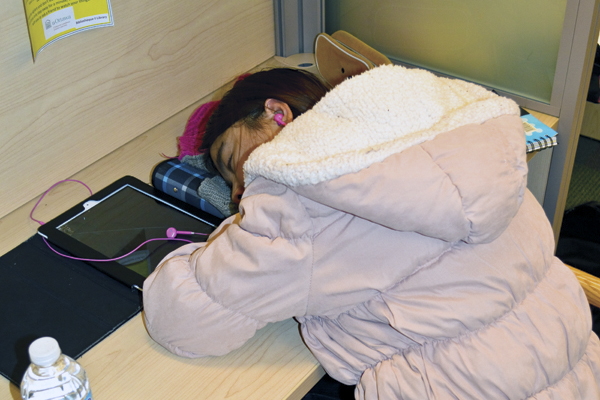Incidence rate of shingles has been increasing in many age groups, including young people, but researchers aren’t sure why
Most people have some general knowledge about chickenpox or may have even experienced it firsthand themselves. Less is known about its second-round heavy-hitting partner: Shingles, also known as herpes zoster. Anyone who has had chickenpox can go on to develop shingles. Public unawareness about the risks of shingles, especially among young people, stems from the view that shingles is an illness that mainly impacts older people. While this stereotype is not statistically wrong, it doesn’t quite paint the whole picture.
About one in three Canadians will develop shingles in their lifetime, according to Statistics Canada. Unlike chickenpox, which typically strikes in the early years of one’s life, those at the highest risk of developing shingles are above the age of 50 or are immunocompromised. The science behind this statement follows sound logic: A weakened immune system (something that occurs with age) increases the risk of the shingles virus re-emerging.
In a given year about 130,000 Canadians will develop shingles, according to the Public Health Agency of Canada, and this number has been increasing among all demographics, but especially in older people. One study published in the BMC Infectious Diseases journal in 2016 that focused on British Columbia found the incident rate of shingles increased from 3.2 cases per 1,000 people in 1997 to 4.5 per 1,000 people in 2012.
But as the incidence rate of shingles increases among adults, according to the Centers for Disease Control and Prevention (CDC), there’s still no definitive answer as to why this trend is occurring, leaving members of the medical community scratching their heads.
Chickenpox’s lesser-known partner
Herpes zoster (HV) — more commonly known as shingles — is caused by a reactivation the latent varicella-zoster virus (VZV). VZV, as a primary infection, causes chickenpox. Once an individual contracts VZV for the first time, they continually carry the virus. For the most part, the virus lies dormant, suppressed by a well-functioning immune system. But with the right combination of factors, the immune system can cease to suppress the virus. This is what causes VZV to become active, and reappear as shingles (HV).
The symptoms of shingles initially include pain, itching, and tingling, followed by a rash that typically occurs in one strip, on one side of the body. The rash usually consists of small fluid-filled blisters. Complications of shingles can include lasting pain, scarring, or infection around the site of rash. More seriously, when shingles occur close to the eyes it has the potential to cause blindness.
Another serious and long term complication of shingles is postherpetic neuralgia (PHN).
Between 10 to 15 per cent of individuals who have a case of shingles will also develop PHN, according to the CDC.
Chetan Mehta, a doctor who specializes in family and addiction medicine based in Toronto explains, PHN as a reactivation of the virus where it irritates the nerve roots, causing inflammation. If allowed to progress without treatment, these nerve roots can become so irritated and inflamed that lasting damage is incurred, and as a result, lasting and debilitating pain.
It is for this reason that Mehta emphasizes how important it is to vaccinate against chickenpox and catch and treat cases of its counterpart, shingles, early.
“For people who are at risk of shingles, or might be about to have an outbreak, they have this tingling on this specific pattern on their body,” Mehta says of the early warning sign. “Before they get the whole outbreak, if we can use antiviral (medication) to suppress it, it really limits replication of the virus and the amount of pain that it can cause.”
This antiviral is most effective when taken within three days of symptoms occurring. There’s also the proactive approach, varicella vaccines. In Ontario, vaccines are free for those between the ages of 65 and 70.
Surprised on all accounts
“I didn’t know anyone with shingles,” says Laura Bassett, a third-year law student at the University of Ottawa. “I didn’t know that young people could get shingles. I didn’t really know what to expect. I was, to be honest, super shocked.”
Bassett came down with shingles in the third year of her criminology degree at Wilfred Laurier University. Her physical symptoms, the typical rash and blisters of shingles, appeared on her right hip. Bassett didn’t think much of the rash, assuming it was similar to the streptococcal infection that had occurred in the same area just a few weeks prior. But by the time Bassett went to see a physician, it was too late: She was told that she had missed the window for treatment of the virus and she would have to let it run its course.
While the rash and physical symptoms persisted for between two to the three weeks, Bassett said, this was short in comparison to the five months of pain as a result of PHN that followed. If Bassett had been able to catch her shingles early, as Mehta explained, she would have likely prevented the five months of ensuing pain that followed.
Bassett experienced shingles as a young adult, but an outbreak can occur in younger cohorts as well.
Jill Burton, a 25-year-old occupational therapist based in Halifax, described how she developed shingles at 13 in an email to The Fulcrum. Her symptoms started off as increasing amounts of pain under her right arm that eventually turned into blisters, preventing her from wearing any sort of tight-fitting clothing.
Burton went to see three different medical professionals — first to a pharmacist — who she said denied a shingles diagnosis because she was too young. She then went to a walk-in clinic where they still had no answers, and finally to the hospital where she finally got a diagnosis.
“Every professional was confused about a diagnosis because of my age,” Burton said.
Burton is lucky, as her diagnosis and subsequent treatment only took about three days. But this isn’t always the case.
The onset symptoms of shingles may vary between individuals. Some experience pain from the beginning and for others the infection first manifests as intense itching.
This was the case for 29-year-old Chris Reith, director of communications and marketing for Wrestling Canada. Unlike Burton, who described both pain and blistering, Reith’s initials symptoms were “itchy” blisters. Reith was 23 at the time and competing for Dalhousie University’s varsity swim team.
He figured his symptoms were an allergic reaction of some kind and nothing more. This was not the case, and Reith got lucky: While attending practice at the pool, his coach recognized the rash on his side as shingles, sending him straight to the campus clinic.
The physician at the clinic, despite being surprised by his young age, diagnosed Reith right away with shingles. Even the nurse taking his blood was surprised by his diagnosis.
“She was like, ‘yeah, I got it when I was 40 and I thought that was young, so this is really young!’” Reith recalled.
The doctor suggested that due to high levels of stress, Reith was more susceptible to the virus. Reith concurred, admitting that between school, swimming, and relationships, he was going through a stressful time in his life.
Reith’s diagnosis runs in parallel with Bassett’s explanation for why she had shingles: At the time, she was working two jobs, studying for the LSAT, and commuting long hours.
“I was under a significant amount of stress and wasn’t dealing with it properly,” she said.
Her physician agreed, surprised as he was, suggesting high stress had lowered Bassett’s immunity and increased her susceptibility to the virus.
Surprised medical professionals appear to be a common theme in many accounts of young people’s experience with shingles.
Dominic Llanos, now a 25-year-old videographer, described his own experience with shingles at 11 years old. After discovering a red scaly rash covering the length of his back, Llanos’ mother brought him to an Ottawa clinic, where he was diagnosed with shingles and prescribed an antiviral cream. From what he remembers, the physician at the clinic was surprised that, at 11, Llanos had shingles.
“They told me that it doesn’t normally happen until people are basically seniors,” he said.
A physician’s perspective
When asked to explain why and how VZV emerges from its dormant state in young, reasonably healthy individuals, Mehta speculated that in some cases there are chronic conditions that can suppress the immune system, allowing the virus to reemerge. These could include diseases such as diabetes, HIV, or chronic obstructive lung disease, meaning young people with these conditions are at higher risk of a shingles outbreak.
Mehta said that even those without an underlying condition could be susceptible, due to a singular event — what Mehta calls an acute episodic illness — such as pneumonia or a really bad cold.
“An acute stressor doesn’t have to be a medical issue,” Mehta said, but can be an emotional one too. “When people have trouble in their relationships or experience a death in their family, or experience some terrible personal loss, that can reactivate shingles.”
Dr. Earl Brown, a virologist and professor emeritus in the U of O’s department of biochemistry, microbiology, and immunology, had similar thoughts to add when it comes to triggering events that could lead to shingles. Brown said it’s possible for an individual to have an infection that transiently suppresses the immune system enough for the virus to resurface. Something as small as a sunburn could lead to a transient suppression.
The evidence is not robust
Some ideas for why the incidence rate for shingles is increasing among some age groups do exist.
One counterintuitive argument being thrown around, which is now thought to be unlikely by the CDC, states that due to the emergence of the varicella vaccine to guard against VZV, a vaccine that has long been used to reduce the severity and incidence of chickenpox, there’s less of the virus in our ecosystems. Coming into contact with small amounts of the wild virus, the argument goes, could be beneficial to our bodily defence by boosting our immunity.
But the CDC noted the incidence rate for shingles was increasing before the chickenpox vaccine was first introduced and did not increase faster when a routine chickenpox vaccination program was launched, pointing to serious flaws in this idea.
Dr. Marc-André Langlois, Canada’s Research Chair in molecular virology and intrinsic immunity and a U of O professor, also warned of accepting this idea in an email to the Fulcrum.
For one, Langlois said there’s not enough evidence for this to be a theory at all. On the other hand, Langlois noted the increase in the incident rate of shingles in people under 40 from the study published in the BMC Infectious Diseases journal was not especially robust nor alarming. In fact, the increase of incident rates of shingles was much higher among older populations.
“The increase (in shingles) is only observed in some age groups,” Langlois said. “There is a clear increase in all groups above 40 years of age and a very, very mild upward trend in the 20 to 40 age group. Shingles incidence in those below 20 years of age has remained largely unchanged for the past 20 years.”
To truly study the incidence rate of shingles among young people, Langlois said, a significant amount of new and challenging research is needed with clear measurements of how increases are measured, along with a better definition of who is considered “younger.”
Most importantly, Langlois underlined that the effectiveness of the varicella vaccine should not be brought into question. While the rates of chickenpox were already on the decline in the United States when the varicella vaccine was introduced in 1994, they plummeted in 2013, the most recent year data was available from the CDC. On the other hand, in 1995 there were 115 deaths from chickenpox, according to the CDC. In 2012, there were close to zero.
“One preventable death is too many when it comes to vaccine-preventable diseases,” Langlois said.
Visibility: Media truths and research facts
Part of the difficulty is deciphering the difference between a rise in cases versus a rise in visibility. As Brown put it “now everybody can take a picture of their shingles and send it around. We couldn’t do that 15 years ago.”
The truth is we really don’t know why more people, among all age groups, are contracting shingles. While data exists on the incidence of shingles, it’s limited and often doesn’t focus on younger populations, or if the study does focus on a younger population, it isn’t asking the right questions.
And while young people shouldn’t be overly concerned with developing shingles, Bassett Llanos, Reith or Burton will tell you just how negative of an experience catching the virus is.
For Bassett, preventing complications of shingles involves raising public awareness.
“I think there needs to be more education on the (things) that can (cause shingles),” she said, pointing specifically to stress.
Bassett emphasized that we often discuss stress under the notion that it is damaging mentally, forgetting that it can have very real physical consequences as well, such as lowered immunity in the case of shingles.





